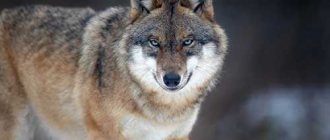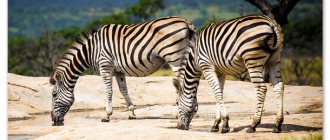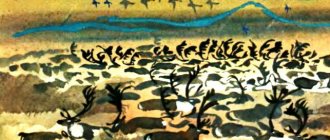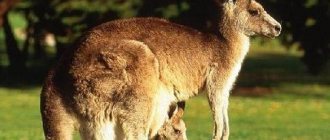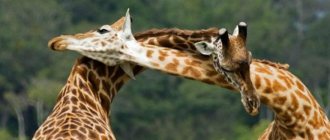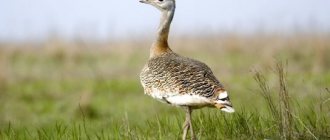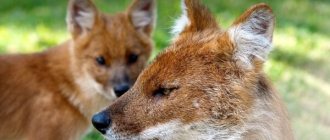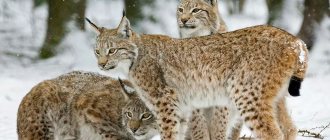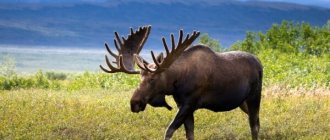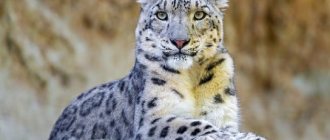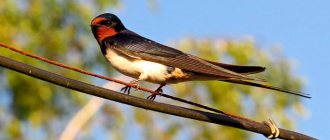The red mountain wolf is a canid predator, also known as the buanzu or Himalayan wolf. Actually, this animal has such a name for a reason - the color of its fur is a rich red color, closer to red. It should be noted that this breed combines several species - the body structure is similar to a jackal, the color is similar to a fox, but as for behavior, everything here is from a brave and formidable wolf. Unfortunately, if the situation does not change soon, the red mountain wolf will only be seen in photographs, as its numbers are rapidly declining. And all because of the negative influence of humans - because of the beautiful fur, the animal is shot.
Scientific classification
- Kingdom: Animalia (animals)
- Phylum: Chordata
- Class: Mammalia (mammals)
- Order: Carnivora (predatory)
- Family: Canidae (canids)
- Genus: Cuon (red wolves)
- Species: Cuon alpinus (red wolf)
The genus Cuon is monotypic, meaning it contains only one living species.
Other names: mountain wolf, dhole, Himalayan wolf, Asian wild dog, buanzu
Reproduction
Little is known about how this species reproduces. There are guesses that females give birth to offspring directly in the crevices in which the family lives. Predators reach puberty in the second year of life, and pregnancy in females lasts 2-2.5 months.
Both parents take whatever part they can in raising the pups, of which there can be from 6 to 10 in one litter. Puppies are born blind and begin to see only after a few weeks of life. At the same time, they develop quite quickly: it takes them a little more than six months of life to reach the size of their parents.
It is also believed that young animals do not leave their parents, and several of their generations unite and form a full-fledged pack.
Varieties
Photo: ZePhyrC4
A total of 10 subspecies of the red wolf have been described:
- Burmese wolf (Cuon alpinus adustus) found in northern Myanmar and Indochina;
- Indian wolf (Cuon alpinus dukhunensis) is found in Central Asia, India south of the Ganges, Afghanistan and Pakistan;
- Asian wolf (Cuon alpinus fumosus) is found in the territory from the Chinese province of Western Sichuan to Mongolia;
- Tien Shan wolf (Cuon alpinus hesperius) is common in China; Eastern Turkestan and Southern Siberia were inhabited until the first half of the 20th century;
- the Malayan wolf (Cuon alpinus infuscus) lives in most of Malaysia, Vietnam and Thailand, as well as southern Myanmar;
- Javan wolf (Cuon alpinus javanicus) found in Java;
- Kashmir wolf (Cuon alpinus laniger) is found in Kashmir, Ladakh, Waziristan and Southern Tibet;
- Chinese wolf (Cuon alpinus lepturus) is distributed south of the Yangtze in China;
- the Himalayan wolf (Cuon alpinus primaevus) has a fragmented distribution in the Himalayas;
- Sumatran wolf (Cuon alpinus sumatrensis) found in Sumatra.
Range, habitats
The main part of the habitat and range of the red wolf is located in Central and South Asia, southern East Asia, including Indonesia, India, China and Tibet, as well as Mongolia, the islands of Java and Sumatra. Within its habitat, in some places such a predator has been completely exterminated or driven out by people, and in some places it is absent over large areas without human intervention. Basically, the predatory animal is absent in the desert and steppe parts of its range.
In the north, the border of the red wolf's range runs through a very narrow strip in Russia. Such wild habitats are represented by the southern outskirts of the Far East, Central and Eastern Siberia, where red wolves are very rare and infrequently encountered. Throughout their usual range, red wolves prefer mountains and hilly ridges.
This rare predatory animal can live in a wide variety of habitats, from alpine meadows, including high-mountain valleys with abundant steppe vegetation, to cedar-broad-leaved forest zones of the Far East, including coniferous forests in Eastern Siberia. However, regardless of the characteristics of the habitat of a pack of red wolves, an indispensable condition remains an insignificant snow cover. Too deep snow always forces the animal to migrate to other, not too snowy areas.
Return to content
Spread range
Geographical distribution
Photo: Wikipedia
Southeast Asia is one of the last strongholds of the endangered red wolf. They are distributed throughout the South Asian region , including countries such as Nepal, Afghanistan, India, Pakistan. There are unconfirmed reports from Central and East Asia.
Previously, red wolves inhabited the southern regions of Altai and Primorye, from where they completely disappeared in the last century.
The spatial distribution of a species is usually determined by the availability of key resources such as food, water and cover. Anthropogenic pressure and other environmental changes may have a negative impact on the species' distribution through modification and loss of suitable habitats.
- Biogeographic regions: palearctic, eastern
Habitat
Red wolves occupy almost all habitat types in the mountainous alpine regions of Asia (hence the name "alpinus"). They have been spotted at altitudes of up to 5,000 meters above sea level. In India, red wolves live almost exclusively in dense forests and bushes.
Photo: Birding Beijing
Red wolves love open spaces and can often be found near riverbeds, jungle clearings and trails where they rest during the day. Their hunting range is about 40 square kilometers. The red wolf can also be found in densely forested steppes and hills. It will never be found on open plains and deserts.
- Terrestrial biomes: forest-steppe, tropical forest, bush
Lifestyle and habits
An excellent hunter, the red wolf unfolds its activities throughout the whole day. A daytime hunt can last for several hours, due to the fact that these are very hardy and bloodthirsty animals. But at the same time, excellent vision and sense of smell leave the victim virtually no chance of escaping pursuit.
An important quality is the excellent interaction of animals within the pack. Organized groups of 10-15 individuals are capable of surrounding the prey from the flanks, thereby leaving only one direction for retreat. And having reached an open place, the wolves as a whole pack attack the target, which can be 10 times or more larger in size and weight than one wolf.
Relationships in a pack are built around one main pair. The main part of the remaining individuals are the descendants of the main pair. In a flock, as a rule, communication skills are well developed: greetings, games and even some kind of negotiations - quiet and frequent sounds.
The flock lives in a relatively small area - up to 40 square meters. km. Wolves actively mark their territory, but not with a personal mark, but with the collective mark of the pack.
Character traits
The fur is usually rusty red on the back with a lighter belly. Depending on the region, the color of the coat can vary from light brownish gray to a uniform red. Wolf cubs are born with sooty brown fur, acquiring adult coloring at three months of age.
Photo: Klaus Rudloff
The fluffy tail is dark with a black tip. The guard hairs of adults on the back and sides are 25 to 30 mm long. Most varieties have a fairly dense light/white undercoat .
In the appearance of the red wolf, the features of a wolf, fox and jackal can easily be traced. However, what distinguishes him from most canines is:
- relatively wide skull with shorter rostrum;
- fewer molars: there is one less molar on each side of the lower jaw;
- 16 mammary glands, dogs have 10 nipples;
- very long tail, reaching half the length of the body.
There is no obvious sexual dimorphism in this species. The length of the head and body is from 88 to 113 cm, the length of the tail is from 41 to 50 cm, the height at the shoulders is from 42 to 50 cm. Adult females weigh from 10 to 13 kg, adult males - from 15 to 20 kg.
Breed characteristics
The red mountain wolf is beautiful and intelligent. The animal is quite large, for this type of predator, in size. The length of the body reaches one meter, and the mass of the red wolf reaches 21 kilograms. The muzzle of a mountain wolf is slightly pointed and shortened, the tail is fluffy and descends almost to the ground. In the winter season, the fur becomes thicker and longer, and its color also changes slightly - it becomes a little lighter, which allows the wolf to hunt effectively. In the summer, the coat becomes shorter and the color darker.
The habitat is quite extensive - from the Tien Shan mountains to Altai. But, unfortunately, this is not proportional to the number, since the number of adults and calves is negligible.
Diet
Eating habits
Diet analysis showed that these are generalist predators . Red wolves are primarily hunters of large mammals. These include sambar deer, Asiatic buffalo, antelope, nilgai, wild boar, mountain goat, ram, gaur, roe deer, musk deer, tahr and goral. Smaller animals such as badgers, hares, various rodents, lizards, insects and sometimes monkeys may also be on their menu.
Photo: Paws Trails
Approximately eighty percent of the red wolf's diet consists of wild prey species; livestock accounts for 15% of the diet; the share of insects and wild berries is up to 5%. Consumption of livestock leads to a negative attitude of the local population towards the conservation of the red wolf population.
Hunting tactics
Unlike many other canids, red wolves rarely kill by biting their prey by the throat. Larger mammals are attacked from behind, while smaller animals are killed by a quick blow to the head.
Red wolves are excellent swimmers , so they often drive their prey into the water, where it is easier to catch it. On land, these predators can accelerate to 50 km/h.
Red wolves compete for food not by fighting, but by the speed of eating prey. An adult can eat up to 4 kg of meat in an hour . Two or three red wolves can kill a 50 kg deer in less than two minutes. It is noteworthy that predators begin to feed on the prey before it dies. Larger prey rarely die from the attack itself, but rather from blood loss and shock.
Interesting facts about the animal
In 2005, the Bank of Russia issued a silver collectible coin in denomination of 1 ruble, on which a red wolf was depicted. A similar campaign took place in Kazakhstan, but this time the image of a rare predator was printed on tenge worth 500 units.
The coins were made of gold-plated silver and have diamond inserts. The red wolf in Kazakhstan is a totem animal and has been revered since ancient times. In addition to coins, the image of a predator in this country is found on postage stamps, etc.
The famous writer Rudyard Kipling immortalized red wolves in his novel The Second Jungle Book. There they are actually described as red dogs. V.K. Arsenyev in his work “Dersu Uzala” described his meeting with a flock of predators in Primorye. Writer Sergei Samarov published a book of the same name “Red Wolves”, combining a story about rare predators and military operations in Dagestan.
Still have questions or have something to add? Then write to us about it in the comments, this will make the material more useful, complete and accurate.
Lifestyle
Red wolves are most active in the early morning and evening, but will sometimes hunt at night. In captivity, they exhibit a clear bimodal rhythm of activity with peaks from 0.5 to 3 hours after sunrise and 2.5 hours before sunset.
Photo: Daniel Sörensen
Red wolves love water very much . After feeding, they run to a watering hole, and sometimes, if the water is near their prey, the predators will briefly leave the food for a small sip of water.
They live in packs of 5 to 12 individuals, periodically interacting with wolves from other groups, but the original pack rarely exceeds 20 individuals. Flocks can break up and later come back together.
Social organization in packs remains largely unexplored, but some scientists point out that "hierarchical disputes" break out in groups between animals of the same sex. Subordinate animals respond to aggressive growling with passive submission, including tucking their tails and lying on their sides.
Photo: Tumgir
Unlike hyenas, red wolf pack members rarely show signs of violent aggressiveness (except in cubs, which like to fight), and bullying almost never occurs.
Popular message topics
- Herbivores
Herbivores or also called herbivores are creatures that eat plants. Such plant products include leaves, roots, fruits, etc. - Astrid Lindgren
“The Sorceress from Sweden” is how the great storyteller Astrid Anna Emilia Lindgren (1907 – 2002) is respectfully called all over the world, from whose pen dozens of wonderful stories came out, - Elk
One of the largest animals living in the forest is the elk. The animal has quite a lot of weight, and its height reaches up to 2 meters. Moose are most often dark brown in color, have a huge body and long legs. The animal's head is round,
Reproduction
Each pack contains a dominant, monogamous pair . Subordinate members of the pack help care for the cubs of the dominant pair. Mating occurs between September and January in India, but in captivity at the Moscow Zoo, individuals usually breed in February.
Photo: Funny Animals
Pregnancy lasts 60-62 days. The female usually gives birth to up to eight young . The average litter size is 4-6 pups. Puppies are born in late autumn, winter and the first spring months (November-April).
Lairs are built near stream beds or in rocky caves. After birth, several other adults take part in feeding the mother and young. The female remains in the den with her pups until 2 days after giving birth.
Photo: Klaus Rudloff
Newborns are blind and covered with dark brown hair. Outwardly, they resemble German Shepherd puppies or gray wolf cubs. Eyes open after 2 weeks. Puppies reach sexual maturity at approximately 1-2 years, and adult masses at 6 months of age.
- Mating system: monogamous
- Breeding season: all year round (in the wild)
- Average number of offspring: 5 cubs
- Weaning: 58 days
- Age of sexual or reproductive maturity: 1-1.5 years (females), 1.5-2 years (males)
Description of the animal
The red wolf is a very unusual predator. His appearance is attractive and never ceases to amaze everyone who meets him along the way. The predator naturally inherited the charisma of a wolf, the flexibility of a jackal and the fur coat of a gorgeous fox. It is also called: mountain wolf, Himalayan wolf or buanzu.
| Scientific classification | |
| Domain | Eukaryotes |
| Kingdom | Animals |
| Sub-kingdom | Eumetazoans |
| No rank | Bilaterally symmetrical |
| No rank | Deuterostomes |
| Type | Chordata |
| Subtype | Vertebrates |
| Infratype | Ghostostomes |
| Superclass | Quadrupeds |
| Treasure | Amniotes |
| Class | Mammals |
| Subclass | Animals |
| Treasure | Eutheria |
| Infraclass | Placental |
| Superorder | Laurusasatheria |
| Squad | Predatory |
| Suborder | Caniformes |
| Family | Canids |
| Genus | Red wolves |
| View | Red Wolf |
| International scientific name | Cuon alpinus |
| Opened | Peter Simon Pallas in 1811 |
| Security status | Endangered species |
| The Red Book of Russia | The view disappears |
What does it look like
The red wolf looks very much like a fox. If you look at it from afar, it is almost impossible to distinguish these two completely different animals. Red, thick fur with a red tint, a long fluffy tail, a sharp muzzle - all this gives it an incredible resemblance to a fox. But in fact, the red-haired predator from the canine family is a full-fledged wolf.
The animal is quite large, strong and hardy. Its dimensions:
- body length – 0.75-1.2 m;
- height at withers – 0.60 m;
- tail length – 0.50 m;
- average weight - from 17 kg (females) to 22 kg (males).
Unlike the gray wolf, this species has a more pointed, narrow head shape. On the animal's face there is a black pattern in the eye area and on the nose. The ears are erect and have a slightly rounded tip at the ends.
Nature painted the tip of the tail black. In the northern subspecies, the fur becomes thicker and longer in winter. The main difference from other representatives of the canine family is the smaller number of teeth in the jaw, instead of 42 there are only 40.
Character and lifestyle
This is an intelligent and dangerous predator. He skillfully avoids traps set by hunters, avoids baits with poison, and is very cunning and inventive. Livestock “cuts” with particular sophistication; it is very difficult to catch and predict its actions.
With all these characteristics, it cannot be killed, since the animal is listed in the Red Book. Therefore, for residents of Russian villages and their hunters, the runs of red predators from the territory of Mongolia or China become a scourge.
The red wolf, compared to its gray relatives, has a more developed vocal apparatus. It often makes sounds (howls) that have a certain musicality. In this case, they say that the red predator sings.
The animal constantly whines, apparently maintaining communication with other individuals. And he also knows how to smile. The animal has well-developed facial expressions, so there is usually no misunderstanding in the pack.
Predators stay in groups numbering from five to fifteen to twenty individuals. There is always a dominant pair in a pack. The relationships of individuals within a flock have been little studied. A strict hierarchy and subordination to the leader is observed. Only the dominant pair is allowed to breed in a flock.
The rest must completely subordinate themselves to the interests of the dominant family, that is, raise their offspring, hunt, defend the territory, etc. Responsibilities can be clearly distributed among members of the pack. Some take care of the puppies, others provide food for them and everyone else.
What does it eat?
Predators obtain their food by hunting deer, wild boar, as well as goats, roe deer and other large game found in the mountains. They do not disdain smaller prey. In the summer they like to eat juicy stems or unblown inflorescences of rhubarb and other greens, thus replenishing the lack of minerals and vitamins in the body.
They go out in search of food at the first rays of the sun. They hunt at night only if the moon is shining brightly and good visibility prevails. During the chase, several individuals pursue the prey. The rest stay a little behind, ready to relieve them at any moment.
Unlike other predators, they do not try to grab the prey by the throat, but bite the entire body until the animal becomes weak from the wounds it receives. They love to drive their prey into water or to a cliff. They are excellent swimmers and, as a rule, victory is on their side.
Interesting! In pursuit of food, it can reach speeds of up to 50 kilometers per hour or more.
Where does it live?
The red-haired predator prefers to settle in mountainous areas, which are also covered with dense forests. It can descend into the plains and deserts, but only in order to find food for itself. The mountain wolf, as this type of predator is also called, does not make holes for itself in the ground. There are quite a lot of caves and crevices in the rocks where it can set up a home.
Animal range:
- The southern half of East Asia (Mongolia, India, China, Indonesia, Tibet, Java and Sumatra);
- Indochina;
- Middle Asia;
- Central and South Asia;
- Some other regions of the planet.
In Russia there is only a narrow strip of range. It covers the outskirts of Siberia and the Far East. However, it is extremely rare to see a red wolf here. Most red wolves are found in India.
At one time, they were actively exterminated here, considering that red predators posed a danger to humans. But as the population of this species depleted, people stopped hunting them, and now the animal is under state protection.
Note! Red-haired predators can also live on flat areas. But the snow cover in these places should not be high so that animals can move easily.
Reproduction
These animals create stable married couples, once for a lifetime. The period of gestation by a female lasts sixty days. In captivity, puppies are usually born in April. They are covered with dark brown fur, blind, without teeth, and their ear canals are closed.
The eyes open only towards the end of the second week. They grow quickly, and within six months they have the size and body weight of an adult. At 1.5-2 years, their body reaches sexual maturity.
As a rule, in a flock only one, dominant pair is engaged in breeding offspring. All other members of the pack are either related to them, or are forced to protect and raise existing puppies.
To prevent young males from leaving the pack in order to create their own families, the female from the dominant pair carries out false matings, during which she does not allow penetration inside. Therefore, he produces his offspring only from his spouse.
The female periodically gives birth to up to nine young at a time. Both parents, as well as other members of the pack, participate in their upbringing. Parents feed very young puppies by regurgitating partially digested raw meat from their stomachs. Slightly older wolf cubs are the first to be allowed into the prey and wait until they are satisfied.
Natural enemies
Despite the fact that gray wolves are very close to their red relatives, mutual understanding has not arisen between them. An ordinary wolf is a larger and more resilient animal, so it has advantages in the struggle for survival in the wild. The gray pack intercepts the main prey, leaving the red wolves to starve. Therefore, these two species, as a rule, do not live in the same region.
The threat to red predators in the wild is represented by individuals from the cat family. These are lynxes, tigers, leopards, leopards and pumas. The latter are larger in size and also eat the same food as red dogs. Therefore they compete with each other. In addition, various diseases (plague, rabies) cause significant damage to the red flock, which spread between individuals with great speed.
Save Status
Red wolves are an endangered, albeit little-studied, species. The existing population is declining throughout its home range due to habitat destruction, persecution by humans, declining prey populations, and disease transmission from domestic dogs. Red wolves are susceptible to plague, rabies and mange. Numerous mites were found on their skin, and their recently abandoned den was infested with fleas.
Two subspecies are listed as critically endangered on the IUCN Red List: Tien Shan and Indian. Two other subspecies are critically endangered: the Kashmiri and the Himalayan.
Population and species status
The red wolf is listed not only in the Red Book of our country, but also in the International Red Book under the status of “Endangered Species”. In this regard, serious efforts are being made on a global scale to save this animal from extinction. In our country, the red wolf is protected at the legal level.
Experts find areas where red wolves live, after which reserves are formed in these areas to protect both the predator and the many animals that serve as food for them. Active work is being carried out with the population to explain the situation in order to prevent accidental shooting of this animal. Today, the total number of red wolves living in nature is not known for certain. This is due to the fact that the red wolf prefers to stay away from humans.
Raising offspring
In the wild it is very difficult to meet a young wolf, especially a cub. This is due to the fact that the adult generation treats their children very carefully. It is not for nothing that people have long associated wolves with freedom and loyalty.
Once born, wolf cubs are completely helpless and cannot exist independently. Parents provide them with food, warmth, comfort and keep the puppies safe.
Only at the age of one year does the younger generation try their hand at hunting. Even if it happens that the wolf cub is lost, its location is determined by howling.
This is a unique radar that allows animals to maintain contact. Also, howling, or “singing,” can serve as a warning of danger.
Winter hunting is in full swing
The hierarchy of the growing offspring is determined from childhood. In various programs or photos you can see how the cubs “play”. But this is not entirely true, because such “sparring” determines a stronger and more worthy descendant.
Sometimes parents have a hard time raising them, as puppies are very curious and brave. This is probably due to the fact that they do not have to face real danger. As soon as the wolf cubs stop feeding on their mother's milk, their diet is replaced by prey that the pack brings to their habitat.
Content
Due to the difference in climate, red wolves tolerate both frost and heat well. This greatly simplifies keeping them in captivity. In zoos and nature reserves, predators are active only during the daytime. Towards evening they hide in shelters, and like to wake up only at noon.
Keeping a red wolf in a zoo
Animals are kept in different rooms. These can be enclosures with either an open or closed roof. This is due to the fact that due to their habitat in rocky terrain, wolves are distinguished by their jumping ability and resourcefulness.
To eliminate this, animals are placed in cages up to three meters high. These enclosures are distinguished by soft lattice, which does not allow wolves to ricochet and leave the boundaries of the place of detention. If hard cages are used, they are equipped with a curved visor on top.
Most often, sand or earth is used as a substrate and concrete is abandoned. This is due to the fact that the concrete surface is heavily heated by the sun and because of this the wolves can get sick.
Red wolf behavior
The red wolf is a typical inhabitant of the mountains, where it can be found at altitudes up to 4000 m above sea level.
The animal prefers to live in the subalpine and alpine zones, in the south of its range - low- and mid-mountain tropical forests, in the northeast - mountain taiga, but everywhere where it lives there must be rocky places and gorges. The red wolf avoids open plains, makes long seasonal migrations during hunting, and occasionally appears in the forest-steppe, steppe and deserts. When high snow cover is established in the mountains, the predator descends to the foothills or southern slopes. Red wolves live and hunt in groups of 5 to 12 individuals of various ages. Animals maintain peaceful relations with each other.
The red wolf's shelters are rock crevices, caves and niches on the slopes; these animals do not dig holes. They have well-developed hearing, they can jump well (up to 6 m in length) and swim. They can reproduce in captivity, but they cannot be tamed, since red wolves always avoid people.
The sounds that red wolves make are very diverse, sometimes they even resemble singing, which is why the species received another name: “singing mountain wolf.”
